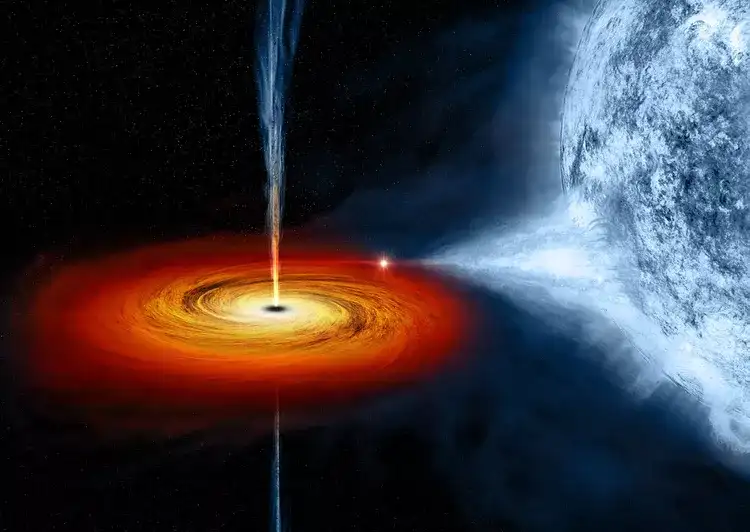Black holes remain some of the most chilling yet captivating phenomena in the universe. Often compared to cosmic whirlpools or massive, dark abysses, these mysterious entities have such an intense gravitational pull that absolutely nothing not even light can escape their grip. Anything venturing too close is doomed to vanish forever, sucked beyond the event horizon into the unknown. (Although, as we’ll discover, that’s not always the end of the story.)
Due to their nature, black holes are utterly invisible to the naked eye, blending into the blackness of space. Scientists have confirmed their existence not by direct observation, but by studying the way nearby stars and gas clouds behave, influenced by the black hole’s monstrous gravity. Additionally, the scorching radiation produced by superheated gas spiraling into a black hole creates X-rays detectable by telescopes. In fact, it was precisely this radiation that led to the discovery of the first black hole, Cygnus X-1, located in the Cygnus constellation back in 1964.
If all this seems like something out of a sci-fi novel, buckle up — reality is even stranger. As researchers continue to unravel their secrets, black holes are proving to be weirder and more wonderful than ever imagined. Here are seven bizarre facts about these cosmic enigmas that will leave you questioning everything you thought you knew about space.
1. Black Holes Twist Time and Space Beyond Recognition
If you were to journey near a black hole, the experience would defy every notion of reality you possess. The extreme gravitational pull would not only slow down time but also severely distort space. As you approached closer, you would be captured into an accretion disk a whirling band of gas, dust, planets, and stars spiraling towards oblivion.
Crossing the event horizon the fateful point of no return you would find yourself pulled inexorably inward. Gravity would stretch you out like spaghetti, a process scientists grimly call “spaghettification.” Beyond this threshold lies the singularity: an unimaginably small point containing immense mass, where gravity becomes infinite and space-time itself bends without limit. Here, known physics simply breaks down, and nothing recognizable remains.
Take a Simulated Journey to the Event Horizon
Visualizing what happens beyond the event horizon remains one of science’s greatest challenges. Simulations can offer a glimpse, but the true experience defies comprehension.
2. Black Holes Come in All Sizes – From Tiny to Gargantuan
Contrary to popular belief, black holes are not all enormous cosmic monsters. They come in a variety of sizes, from minuscule to mammoth. Stellar-mass black holes, the most common type, are born when a massive star explodes in a supernova, leaving behind a dense core that collapses under the weight of its own gravity. This collapsing matter becomes compressed into an infinitely dense point known as a singularity, surrounded by a fiercely strong gravitational field.
Stellar black holes typically weigh about 10 times more than our sun, though some discovered specimens are significantly heavier. They act not as gaping holes, but as almost invisible knots of ultra-dense matter that exert colossal gravitational forces on their surroundings.
Even larger and more mysterious are supermassive black holes. These giants, with masses billions of times greater than the sun, sit at the centers of nearly every galaxy, including our own Milky Way. The Milky Way’s core is home to Sagittarius A* (Sgr A*), a supermassive black hole packing the mass of about 4 million suns into a relatively small space.
Scientists still puzzle over exactly how supermassive black holes form. Some theories suggest they might have appeared very early after the Big Bang, growing rapidly as matter collapsed around them. Recently, researchers have also proposed the existence of tiny primordial black holes, created mere moments after the Big Bang. These hypothetical entities could be smaller than an atom but weigh as much as a mountain, silently lurking throughout the universe.
Stealth Black Holes Add to the Mystery
Adding another twist, astronomers have recently detected “stealth” black holes those that consume material at a slower rate and emit far less radiation, making them incredibly difficult to observe. Their elusive nature suggests that the universe could be even more packed with hidden black holes than previously imagined.
3. Black Holes Are So Numerous They Defy Counting
Estimating the total number of black holes in the universe is like trying to count the grains of sand on all the beaches of Earth. Even within our own Milky Way galaxy, astronomers believe there are between 10 million and one billion stellar-mass black holes quietly lurking in the cosmic shadows. That figure doesn’t even include Sagittarius A* at the center of the galaxy the supermassive heavyweight that anchors our galactic structure.
Expand that estimate across the 100 billion galaxies thought to populate the observable universe, each harboring millions of stellar black holes and at least one supermassive black hole at its core, and the numbers become truly staggering. Black holes might not just be common they could be the norm, silent architects shaping the cosmos at every scale.
4. Black Holes Consume Matter – and Sometimes Spit It Back Out
Although black holes have a fearsome reputation as cosmic vacuum cleaners, they are not actively hunting down matter. Instead, they consume only material that ventures too close, often drawing it from surrounding gas clouds or unfortunate nearby stars. One dramatic example involves astronomers observing a star being devoured over the course of a decade the longest black-hole meal ever recorded.
Despite their reputation for annihilation, black holes are surprisingly messy eaters. Some matter near the event horizon doesn’t actually fall in. Instead, it can get caught in magnetic fields and flung outward at incredible speeds, forming what scientists call “relativistic jets” beams of plasma traveling at near-light speeds.
Beware of Cosmic Spitballs
In the case of Sagittarius A*, researchers have detected massive blobs of matter, or “spitballs,” being ejected into the galaxy at velocities reaching 20 million miles per hour. These planet-sized fragments originate from material in the accretion disk that escapes consumption and instead is hurled outward. Though the odds are slim, such a rogue spitball traveling through space could one day pose a real threat to any unlucky planet it encounters including Earth.
5. Supermassive Black Holes Can Create Stars and Regulate Galaxies
Though black holes are often associated with destruction, they also play a surprisingly creative role in the universe. Recent discoveries reveal that supermassive black holes can eject enough matter to form new stars. Incredibly, some of these stars are born not within galaxies but in intergalactic space rogue stars drifting far from their original homes.
Even more fascinating, research published in 2018 suggests that black holes may govern how many stars a galaxy produces. Scientists found that galaxies with relatively smaller central black holes experience a faster shutdown of star formation. In contrast, larger supermassive black holes seem to regulate the flow of gas in such a way that star formation continues longer. Essentially, the size of a galaxy’s black hole can directly influence its future growth and evolution.
Black Holes as Cosmic Architects
Far from being passive bystanders, black holes actively shape the structure and destiny of galaxies. Their influence extends across millions of light-years, molding the distribution of stars, gas, and even dark matter in ways scientists are only beginning to understand.
6. Scientists Have Captured Images of Black Hole Event Horizons
For decades, black holes were purely theoretical constructs, invisible to even the most powerful telescopes. That changed in 2019 when the Event Horizon Telescope (EHT), a collaboration of nine linked radio telescopes around the world, captured the first direct images of a black hole’s event horizon. This groundbreaking achievement provided visual evidence of these mysterious cosmic giants.
The first image revealed the supermassive black hole at the center of the galaxy Messier 87, located 53 million light-years away. Dubbed “Pōwehi,” this black hole appeared as a glowing ring of superheated gas surrounding a shadow the telltale signature of the event horizon itself. Shortly afterward, the EHT captured another historic image: Sagittarius A*, our very own Milky Way’s central black hole, offering humanity an unprecedented glimpse into the heart of our galaxy.
A New Era of Black Hole Exploration
These images not only confirmed decades of theoretical predictions but also opened new avenues of inquiry into the nature of space-time, gravity, and the true behavior of black holes. Each new observation brings scientists closer to understanding the deepest secrets of the universe.





